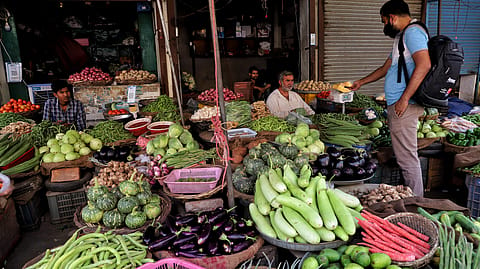Retail inflation eases to 5.48% in November—Will RBI cut the repo rate?
As India's retail inflation eases in November, economists anticipate a further decline due to softening vegetable prices, a favourable base effect, and increased crop supply

India's retail inflation eased to 5.48% in November after crossing the RBI's upper tolerance band of 6% in October 2024, thanks to the influx of fresh farm produce that helped soothe the vegetable prices. With this, the retail inflation has fallen back within the medium-term target range and offers a dose of relief.
"Year-on-year inflation rate based on All India Consumer Price Index (CPI) for November 2024 over November 2023 is 5.48%. Corresponding inflation rates for rural and urban are 5.95% and 4.83%, respectively," says the Ministry of Statistics & Programme Implementation (MoSPI).
Food inflation, based on the All India Consumer Food Price Index (CFPI), dipped to 9.04% in November 2024. The corresponding inflation rate for rural and urban was 9.10% and 8.74%, respectively.
Retail inflation had worryingly soared further to a 14-month high of 6.2% in October 2024, breaching the upper limit of the MPC's medium-term target range of 2-6%. The CPI inflation had risen from September's inflation rate of 5.5%.
Economists predict further softening
The economists say retail inflation is expected to decline further due to various positive factors like softening of food and beverages prices, favourable base and increased crop supply.
Ratings agency ICRA estimates the headline CPI inflation to soften further to 5.1% in December 2024 from 5.5% in November 2024. The data shows rabi sowing has also picked up. "The cumulative sowing of rabi crops exceeded the year-ago levels by 1.5% YoY by December 9, 2024, led by pulses, rice, wheat and coarse cereals, whereas the rabi sowing for oilseeds contracted by 4.3% YoY," says Aditi Nayar, chief economist and head - research & outreach, ICRA.
Recommended Stories
Aditi Gupta, economist, Bank of Baroda, says the moderation in inflation is on expected lines. "Inflation in the vegetables category moderated significantly, which is a big positive. The inflation trajectory is shaping up on expected lines with further moderation expected in the coming months."
Upasna Bhardwaj, chief economist, Kotak Mahindra Bank, says the November CPI inflation came broadly in-line with expectations. "While the Q3 average is expected to remain elevated we see the winter crop arrivals to provide relief in the coming months."
Notably, the easing of retail inflation comes after the Finance Ministry, in its monthly economic review report last month, had said there could be some good news on the food inflation front in November as it estimated bumper kharif production would lower food inflation in near-term.
Will declining trend continue?
(INR CR)
After December 2023, the general retail inflation rate and food inflation declined and had reached its lowest point in July 2024. However, from August 2024 to October 2024, an increasing trend was observed. This time again, the retail inflation has declined and economists hope the trend could continue.
Arsh Mogre, economist institutional equities, Prabhudas Lilladher Capital, says India’s CPI inflation data for November 2024 provides a glimmer of optimism for policy continuity under the new Reserve Bank of India (RBI) Governor. "This marks a welcome shift after three consecutive months of inflation exceeding the Reserve Bank of India’s (RBI) upper tolerance limit."
The MoSPI data shows housing inflation rate, compiled for the urban sector only, came in at 2.87% in November 2024 vs 2.81% in the previous month.
Among the other categories, meanwhile, a significant decline in inflation was observed in vegetables, pulses and products, sugar and confectionary, fruits, eggs, milk and products, spices, transport and communication and personal care and effects subgroups in November 2024.
The top five items showing the highest year-on-year inflation were garlic (85.14), potato (66.65), cauliflower (47.70), cabbage (43.58) and coconut oil (42.13). The lowest inflation rate were jeera (-35.04), ginger (-16.96), LPG-excluding conveyance (-10.24) and dry chillies (-9.73).
A case for rate cut by RBI?
The moderation in retail inflation strengthens the case for monetary easing by the Reserve Bank of India (RBI). The repo rate has been steady at 6.5% for eleven consecutive meetings, signalling the RBI's caution amid persistent inflation and slowing growth. However, with softening inflation figures, the MPC under new governor could loosen the policy.
"We continue to expect the RBI to cut the repo rate in its February 2025 meeting, aligning with the new governor's commitment to policy continuity and a calibrated approach to fostering growth," says Mogre of PL Capital.
In fact, some expect the MPC to go for two consecutive rate cuts. Nayar of ICRA says if the headline CPI inflation eases to 5% or lower by December 2024, the likelihood of a rate cut by the MPC in its February 2025 meeting would be very high. "We maintain our baseline expectation of two rate cuts of 25 bps each in the awaited rate cutting cycle."
BoB's Gupta also believes the downward trajectory in retail inflation would give the RBI's MPC some confidence to cut rates, particularly since core inflation has not exerted significant upward pressure on the headline print.
Kotak Bank's Bhardwaj cautions that global environment and food price volatility will be key risks to the timing of the monetary easing cycle.
Mogre agrees, saying that this expectation hinges on sustained declines in food prices, stable global commodity markets, and minimal disruptions from geopolitical or weather-related shocks. "For now, the easing inflationary trajectory signals a cautiously optimistic outlook for monetary policy and economic stability."